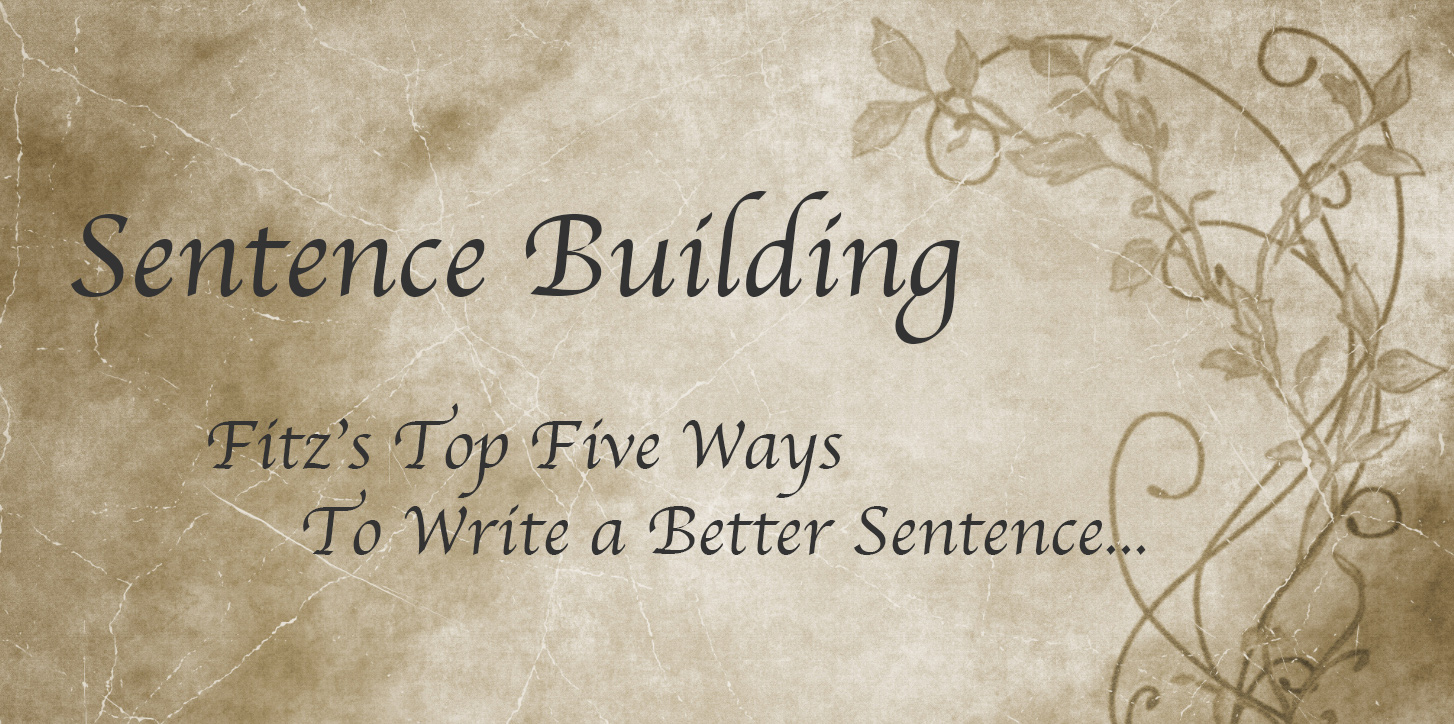
Essential Detail…Images & Actions…Parallel Structure…
Similes & Metaphors…Muscular Verbs
All the Christmases roll down towards the two-tongued sea, like a cold and headlong moon bundling down the sky that was our street; and they stop at the rim of the ice-edged, fish-freezing waves, and I plunge my hands in the snow and bring out whatever I can find. In goes my hand into that wool-white bell-tongued ball of holidays resting at the rim of the carol-singing sea, and out come Mrs. Prothero and the firemen.
~Dylan Thomas, A Child’s Christmas in Wales
Words by themselves don’t mean much—an uttered sound that means something or performs some small task to splice words together into phrases and fragments that focus and complete thoughts and become sentences that morph into meaning—and sometimes magic.
And that is pretty cool. So cool that I have spent some forty years and more trying to figure out the art and craft of writing well. Many another pen has spent more time more assiduously perfecting the writer’s craft, and there is nothing here that breaks new ground. Good writers will be equally appalled at what is missing as they might be impressed by what is included.
But these five techniques are not for them, but rather for those aspiring souls who simply want to become better, more confident and more capable writers by learning and practicing some essential writing skills for writing better sentences.
Try these on for size and see how they fit. They will last a long time.
~Fitz
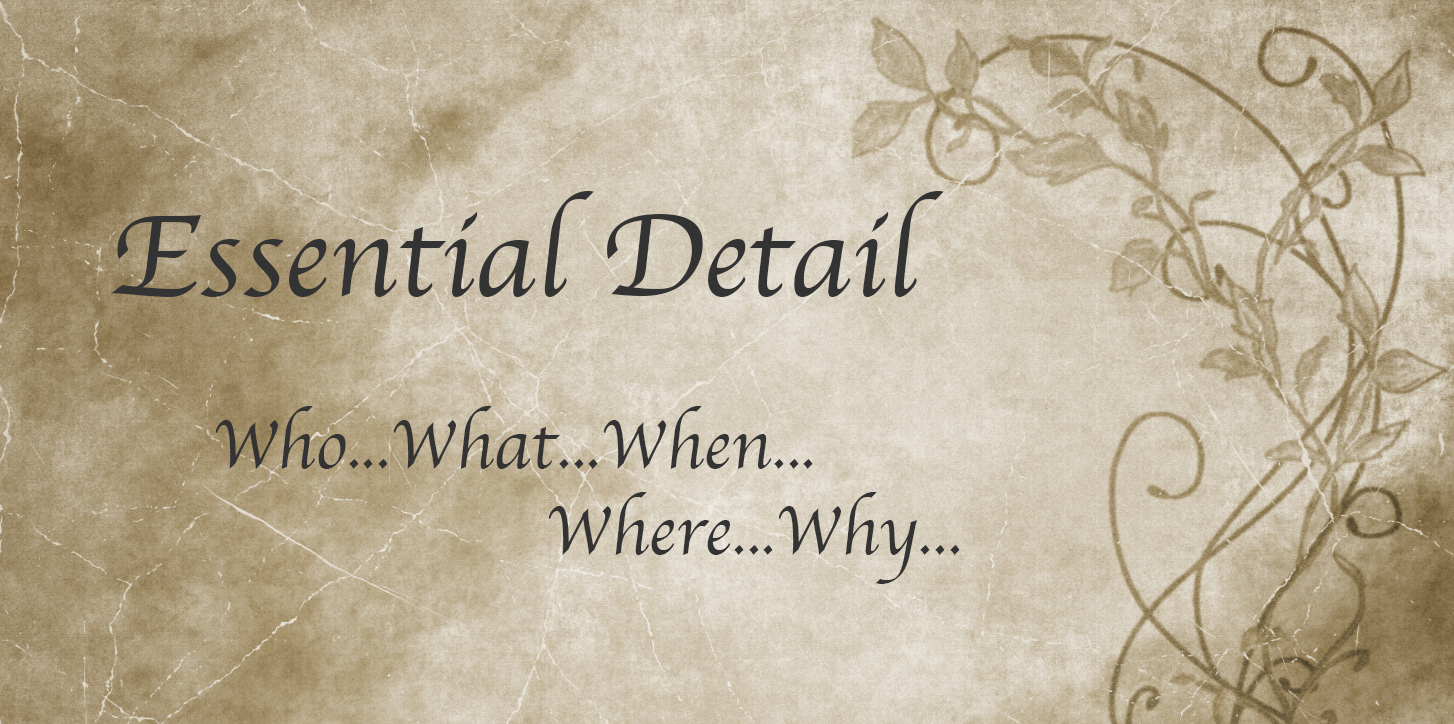
#1: Essential Details
Who…What…When…Where…Why?
One of the most common problems with sentences is that they just don’t tell the reader enough or give enough detail to inform and edify a reader. In the same way that any writing piece should always cover who/what/when/where/why, so should sentences—whenever possible. In many cases, this information might be in the sentence before or after, but it is certainly good practice to incorporate who/what/when/where/why into sentences that benefit from this attention to detail.
Here are two simple rules for helping to make your sentences more informative, detailed, and interesting to your readers.
Fill in the Blanks:
Don’t make a reader try to figure out what you are writing about. Fill in the details that help a reader see and know what you are writing about.
For Example…
~He hit a home-run that ended the game. (Dullsville)
~With two outs gone and David Ortiz saved the day with a towering walk-off home run over the Green Monster in left field. (This was a great game!)
Be Specific:
Identify every “thing” you state. Give people names and titles. Tell us what cereal you are eating, what car you are driving and what cleats you are wearing. Doing this enables a reader’s mind to “see” exactly what you want he or she to see (and feel) and your writing is now infinitely more refreshing, lively and informative to read.
For Example…
~I went fishing today, and it was fun (Holy horrible)
~Billy, Owen and I went to White’s Pond today at five in the morning and fished with spinners and spoons until we filled our basket with enough trout, bass and catfish to feed a starving army. (Now this is a real fish story!)
~I got a bike today. (I’m not jealous)
~My rich Uncle Fred surprised me on my birthday with a Yeti Cycles SB6 Turq XX1 Eagle Mountain Bike. (Now I am…Look it up!)
Here is a poem that uses essential details to create the scenes and actions within the poem…
Making It Work
EJ and Pipo squat in the driveway
and poke their heads through
the wheel-well and pass
a half inch socket
and a cold can of WD 40
to my bloodied hand.
I shout out to them:
“The transmission cooler line
is completely shot,
and the thread
on the flare nut
is stripped bare—
it turns, but won’t catch,
into the radiator.
In short: we’re screwed.”
Bellied on the crumbled paving
I hear them giggling
and splashing in the oily cold
puddle I am soaked in.
While Pipo runs to get
the extra red hose we used
to fix the heater on the bus,
I send EJ to get the cement
we used to fix the gasket
on the wood stove.
In my sarcophagus
under the old Buick wagon,
I fumble through my pockets
and find some hose clamps
that just might work.
EJ slathers the flare nut
in an icing of black glue.
And so Pipo can use
his beloved tape measure,
he cuts me a piece of red hose
18 ½ inches long—exactly.
There is no turning back now:
I cut out the old line
and jam the flare nut
into the fitting
until it sets.
For a few minutes, everything
is dead serious:
Pipo lays on his belly
and fits the 18 ½ inch hose
to the cleanly cut ends
of the cooler lines.
EJ takes his flathead
and tightens the hose clamps,
while I keep
the damn flare nut
from moving.
And in the stale air,
beneath a 1988 Pontiac LeSabre Wagon—
soaked in mud, love, oil and anti-freeze—
I am the luckiest man alive.
~Fitz
Exercise#1:
Write five sentences that include of the who? what? when? where? and why? details. The order of who/what/when/where/why is not important. Put the details (who, etc) within parentheses in bold.
For Example…
The young soldier (who) lugging a fifty-pound pack (what) struggled all night (when) through the jungle (where) to reach his base camp before the enemy could reach him (why).
Exercise#2:
Add essential details to these sentences to make them more full and informative. You can change any words, but you can’t change the idea of the original sentence.
~Supper was good.
~The game was exciting.
~I love going to interesting places.
~I have a really cool teacher.
~I should do my homework.
Exercise#3:
Pretend you are a news writer and write a newspaper article about a game or event you saw or were participated in. (300 words minimum)
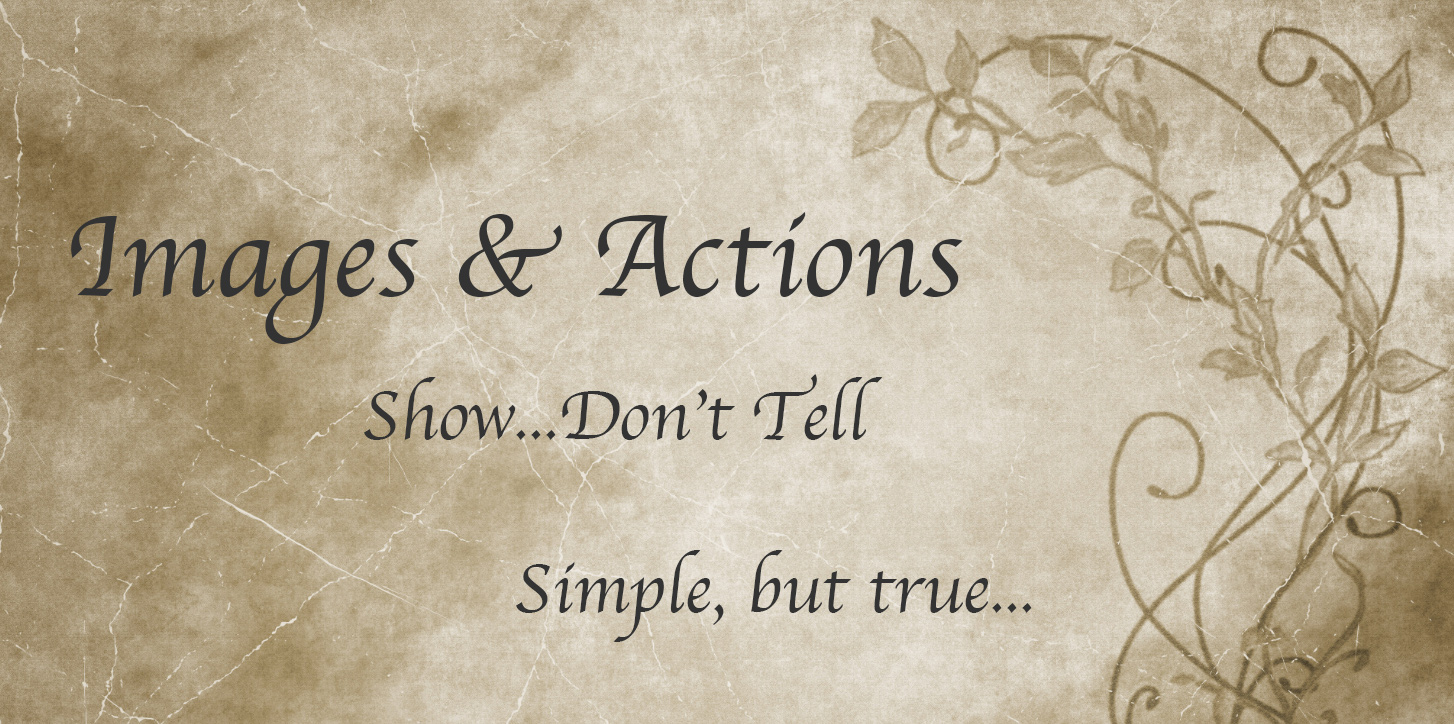
#2: Imagery and Action
Show, don’t tell…Simple, but true…
It is our job as writers to spark our readers’ imaginations! A lot of writers forget that readers are not “in your head.” The readers can’t “see” anything that is not “specifically” described. Simply saying, “It was a cold day” can mean something completely different to different people depending on the time of year or their place on the planet. So wake up! As you write, be conscious of your reader’s inherent predicament, and be sure to give them the needed imagery and actions to make your thoughts become less vague and more real.
Here are three techniques for creating effective imagery and action.
Image & Action:
Using images and actions to create a vivid and visual experience for your reader is a powerful method for engaging and keeping your audience interested in what you are writing—and that has to be the primary goal of all writers. The most effective images and actions are created using specific nouns and verbs—a specific something doing a specific something.
For Example…
~She ran down the street. (This doesn’t tell us much)
~Ginny down the dusty road prancing like a drunk peacock. (I used a simile to create an image)
~The red car pulled out of the driveway. (We have no idea what this really “looks” like)
~The classic red Mustang convertible barreled out of the gravely driveway and onto the tame pavement on Birch Street. (Oh yeah, a cool car and a crazy dude in a sleepy town!)
Image on Image + Action:
Juxtaposed images connected with a prepositional phrase give the reader more context to see (and feel) the action. Create images using nouns and “essential” adjectives. An essential adjective is something like: a “red” rose; whereas, a non-essential adjective would be a “beautiful” rose.
Then let the images do the action!
For Example…
~The rubber ball in the new snow slowly disappears.
~Three barefoot children stomp a dark puddle on the dry street
~On a withered branch a solitary crow caws.
Narrowing and Expanding: Give me the universe, and I will show you a pebble. Give me a pebble and I will show you the universe…
I often teach this technique of big to small—small to big as a way to develop a theme or thesis in an essay, but it is also an effective technique that creates a compelling scene using complementary, yet often disparate, images. It is similar to using the “image on image” technique, except here we emphasize the contrasting size and action between two images to create a single image.
For Example…
~The moon drifts slowly over a dark and angry sea.
~Not even yesterday’s blizzard could pluck the last leaf from the weary oak.
~We saw the headlights winding slowly up the long road on the broad plateau.
Here is a poem that uses all three Images & Actions Techniques to tell a story of a simple day at the beach with the family…but with a deeper message.
The Tide
They are building a world
and the plastic is fading:
Margaret and Eddie’s
buckets are split,
pouring out the warm Atlantic
as they race
along the tidal flat,
filling pools connected
by frantically dug canals.
Tommy squats naked
and screams in guttural joy
at the solitary horseshoe crab
donated by a stranger
with a large belly
and a huge smile.
Charlie thrashes through the shallows
chasing crabs
and impossible minnows.
Emma is happy
to let only the wind
fill her net.
Pipo steps warily
and warns us sternly
in his broken English
to watch out for
the massive toad lurking
in the undertow.
Kaleigh stands far away,
her toes lapped
by the edge of gravity.
She is almost a teenager.
I see her
framed in a setting sun,
stretching out her arms,
holding back
The inevitable tide.
~Fitz
Exercise #1:
Use specific imagery and actions to make these sentences more image rich.
The tree fell in the woods.
The plane flew through the sky
I am not feeling well today.
The baseball game was fun.
I like ice cream.
Exercise #2:
Write five sentences using Image on Image + Action
Exercise #3:
Write five sentences using Narrowing & Expanding
Exercise #4:
Write a paragraph or poem that uses all three Imagery and Action techniques:
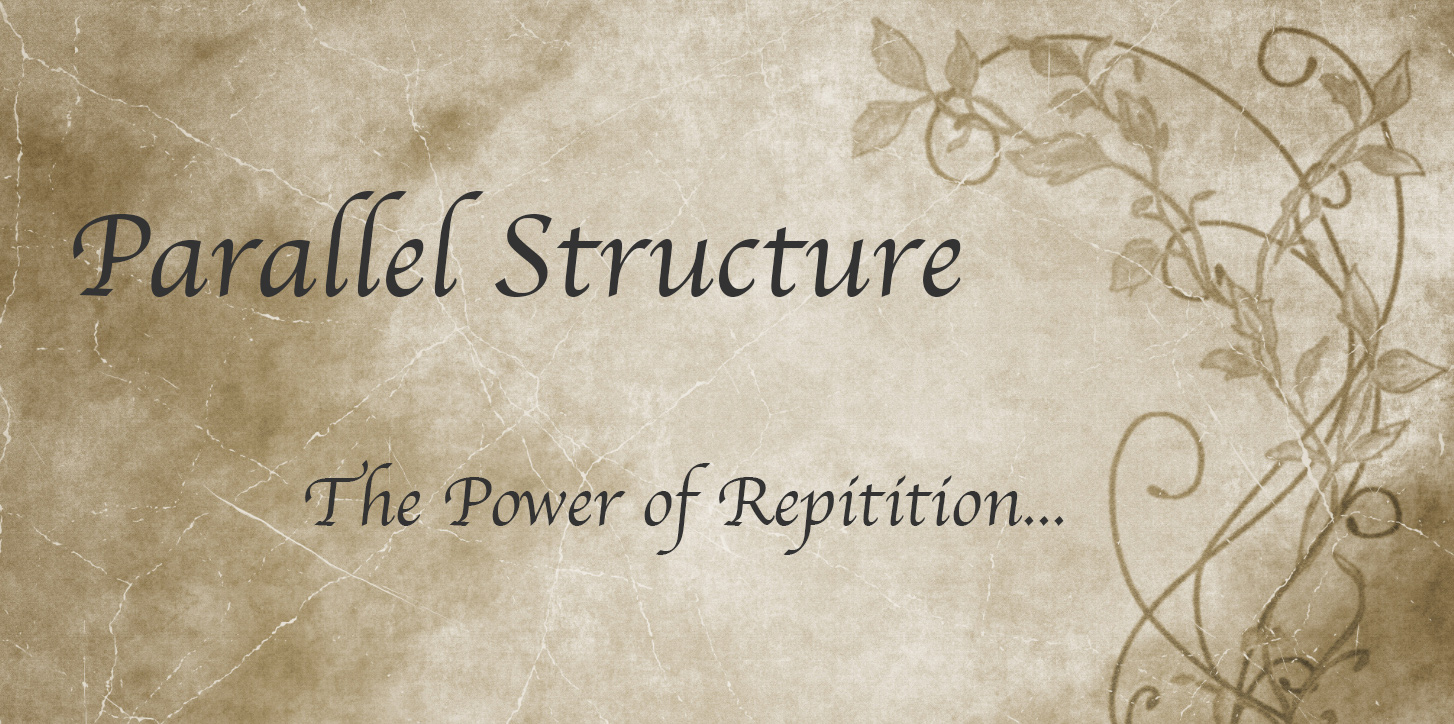
3. Parallel Structure
Repetition for Effect
Parallel Structure (also known as parallelism) employs the repetition of words, word types, and phrases to emphasize and amplify an idea, thought, experience or fact by adding a rhythmic and powerful cadence to prose and poetry (where it is also called “anaphora).
Types of Parallel Structure:
Words:
Sometimes a single word repeated a few times can add a compelling effect to a series of thoughts:
For Example…
~Believe in yourself; believe that you are the master of your fate, and believe that what you are pales beside what you can be.
Word Types:
Several adjectives used in a series of words creates a rhythmic and powerful parallel structure
For Example…
~You are rude, insensitive and selfish when you could be sweet, kind and giving.
Phrases:
Phrases are like short riffs or–a series of notes in a song–that insert an added punch to the melody. In writing, it is similar. A short series of words “phrased” in an interesting way draws attention to itself and creates a powerful cadence and rhythm to a writing piece. It can be used to effectively organize, clarify, unify, and emphasize a specific point, thought, idea or fact. It is a rhetorical technique that has been employed for thousands of years because IT WORKS!
A wise writer knows when and where (and when not) to use Parallel Structure to draw attention to an important passage.
For Example…
In his “I Have a Dream” speech, Martin Luther King utilizes parallel structure to amplify his thoughts on human justice. The dream he expressed here could just be stated, but by use of parallel structure his dreams are more powerful and memorable.
I say to you today, my friends, so even though we face the difficulties of today and tomorrow, I still have a dream. It is a dream deeply rooted in the American dream.
I have a dream that one day this nation will rise up and live out the true meaning of its creed: “We hold these truths to be self-evident, that all men are created equal.”
I have a dream that one day on the red hills of Georgia, the sons of former slaves and the sons of former slave owners will be able to sit down together at the table of brotherhood.
I have a dream that one day even the state of Mississippi, a state sweltering with the heat of injustice, sweltering with the heat of oppression, will be transformed into an oasis of freedom and justice.
I have a dream that my four little children will one day live in a nation where they will not be judged by the color of their skin but by the content of their character. I have a dream today.
In this biblical poem, the use of the phrase “a time to” introduces a series of contrasting realities, quite effectively I might add as this has been a popular poem for several thousand years.There is a time for everything,
There is a season for every activity under the heavens:
a time to be born and a time to die,
a time to plant and a time to uproot,
a time to kill and a time to heal,
a time to tear down and a time to build,
a time to weep and a time to laugh,
a time to mourn and a time to dance,
a time to scatter stones and a time to gather them,
a time to embrace and a time to refrain from embracing,
a time to search and a time to give up,
a time to keep and a time to throw away,
a time to tear and a time to mend,
a time to be silent and a time to speak,
a time to love and a time to hate,
a time for war and a time for peace.
~Ecclesiastes 3
Creating Clarity & Conciseness:
Parallel structure can also be used to express your ideas in a more concise and compelling way.
For Example…
Original Sentence: Suzie is always willing to help around the house, and she does chores with being asked, while all the time seeming happy to help out. (25 words)
New Sentence: Suzie is always willing to help around the house, to do chores without asking, and to seem happy to help out. (21 words)
Exercise #1:
Create five sentences that show the use of single words to create parallel structure. Use the word at least three times in the sentence.
Exercise #2:
Create five sentences that show the use of word types (adjectives, nouns or verbs) to create parallel structure. Use the word type at least three times in the sentence.
Exercise #3:
Create five sentences that show the use of similar phrases to create parallel structure. Use the phrase at least three times in the sentence.
Exercise #3:
Rewrite these sentences by adding parallel structure. Your new sentence should retain the same meaning but be more clear and concise (and fewer) words—which is always a good practice as a writer.
Original Sentence: The mountains in New Hampshire are beautiful because they are big and rocky, and they are majestic, which makes them breathtaking to see. (24 words)
Original Sentence: I have always hated to do writing exercises that have no purpose, and that are hard to understand and which take forever to finish. (24 Words)
Original Sentence: I am the kind person who likes to play outdoors and go for walks in the woods, and I also like to climb big trees. (25 words)
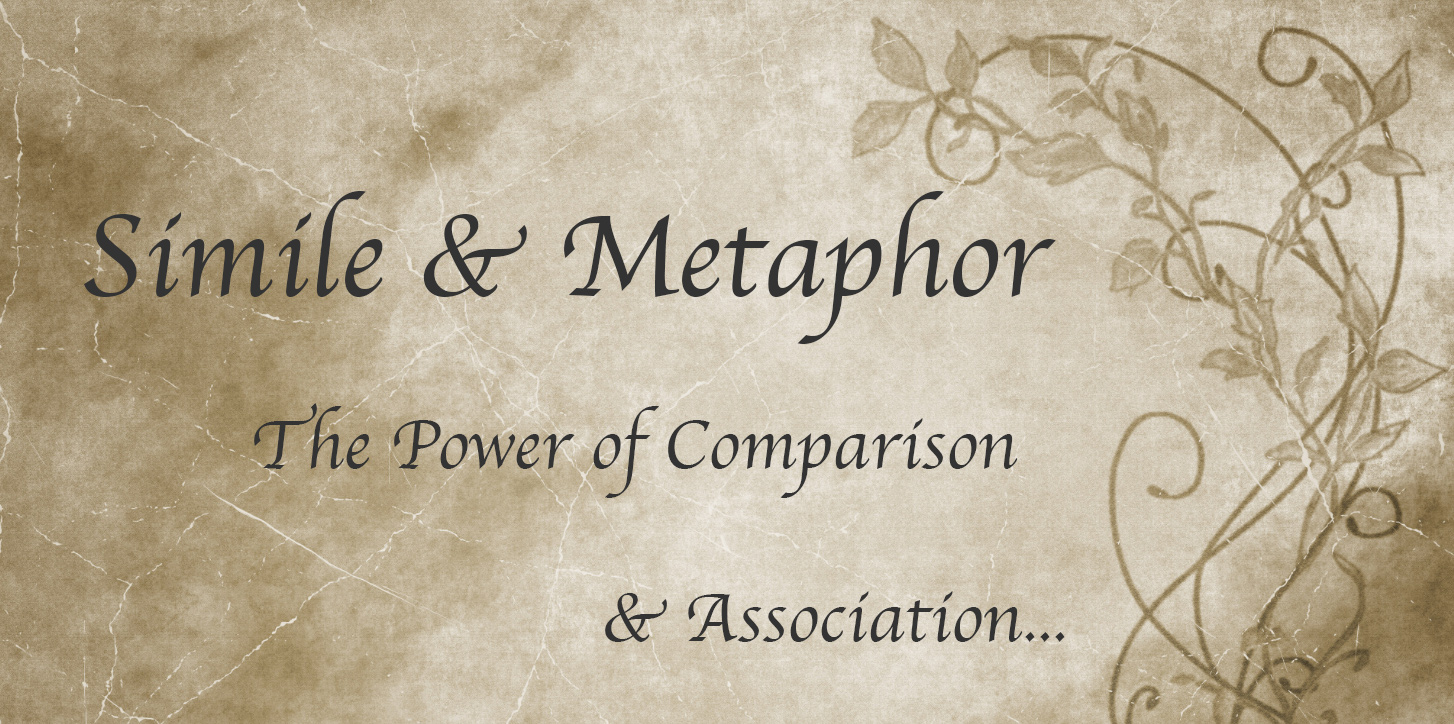
4. Similes & Metaphors
The Power of Comparison
Similes:
Adding a simile to a sentence is a way to spark a reader’s imagination by adding a new and more powerful image into the sentence that compares two things that are not alike, usually using the word “like” or “as” to make the link.
For Example…
~That plumber smells weird. (What’s weird to you might not be weird to me)
~“He smelled like a plumber’s handkerchief.” ~ Raymond Carver (Yes, that is a weird smell
~The lion roared loudly. (So dull! All lions do the same)
~The lion roared like a monstrous hurricane bearing down on a rocky coast. (Now we’re talking. Get out of his way!)
~He was really cold. (How cold is he?)
~He was as cold as a freeze pop in an ice cube tray. (Now I know how cold he really is!)
~That kid is fast. (Compared to what?)
~That kid is as fast as a runaway train. (But now I “see” how fast he is!)
Here is a famous example of similes (and parallel structure!) being used in a poem…
~Robert Burns
Exercise #1:
Use similes to make these sentences more interesting. Be as creative and daring as you wish!
~I am bored.
~The day was hot.
~The meeting was long.
~The hamburger was horrible.
~I am excited to go on vacation.
Exercise #2:
Now try writing five sentences of your own from scratch!
Like any writing technique, you want to use similes with care—like sprinkling salt on your food. You don’t want them everywhere, but when it feels right, go for it. You can always edit and revise later.
Metaphors:
Simply put, a metaphor states that one thing “is” another thing. It is used to make a comparison that one thing has the qualities of another thing. Unlike a simile, a metaphor can be used throughout a writing piece.
For Example…
~My teacher is mean and unpredictable! (So is mine)
~My teacher is a rabid beast! (Oh, man, that’s horrible!)
~I am really strong. (How strong are you?)
~I am a molten ball of iron. (Yikes! I won’t mess with you.)
~Everyday my mother hounds me to clean my room. (Must be messy)
~I come home every day to a fluttering, chattering bird pecking me until I clean my nest. (Now this is a tough situation!)
~When that pretty girl walks down the hall, I get flustered and say and do stupid things. (It’s ok. You just get embarrassed easily)
~When that pretty girl walks down the hall, I become a drooling puppy dog wagging my tongue more than my tail. (What a foolish, lovestruck puppy you are. I have to see this sometime!)
Here is an example of metaphor being used in a poem…
I have been here before
Trying to pull a final day
Back into the night,
Trying to execute
Some stay of time,
Some way to wrap
The fabric of Summer
Around the balky,
frame of Fall, sloughing
My skin, unable to stop
This reptilian ecdysis—
This hideous morphing
Into respectability.
My students, tame
As lab mice, won’t understand
My unblinking eyes,
The hissing of my speech,
The lisping of my tongue,
The expansive hinge of my jaw
Or my insatiable appetite—
Until I swallow them whole
Into my elongating belly, feasting
On their impeccable,
Transient joy.
~Fitz
Exercise #3:
Use metaphors to make these sentences more interesting. Be as creative and daring as you wish!
-
- I am bored.
- The day was hot.
- The meeting was long.
- The hamburger was horrible.
- I am excited to go on vacation.
Exercise #4:
Now try writing five sentences of your own sentences using metaphors!
Exercise #5:
Write a poem that uses metaphor
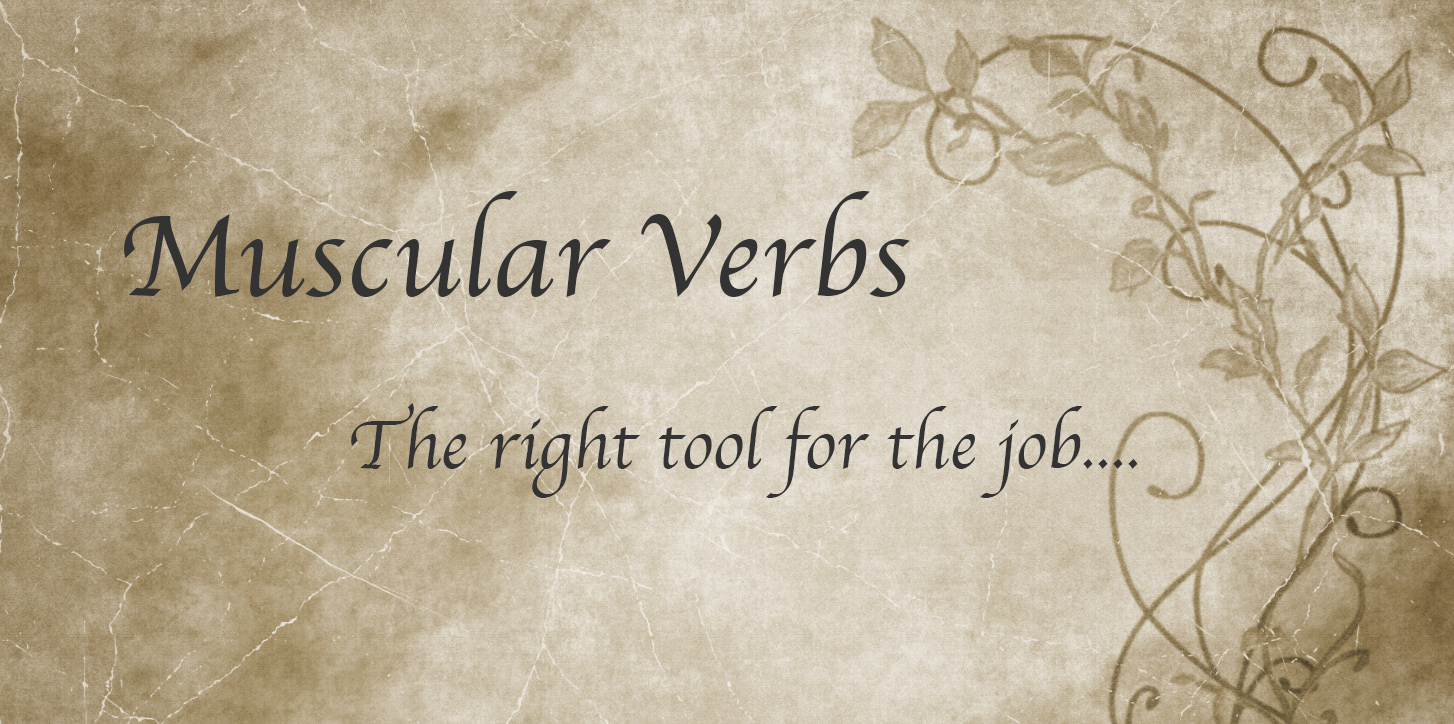
5. Muscular Verbs
The right tool for the job
There are a gazillion verbs to choose from in the English language, so why use the same tired old verbs over and over? A strong verb adds more power, punch and clarity and conciseness to your writing piece. Anytime you feel the need to add an adverb to a verb, you should think long and hard to find a “muscular” verb that more effectively creates and describes the action.
For Example…
~That new kid runs so fast up the hill. (OK, but so common)
~That new kid bolts up the hill. (Better and more clear and concise!)
~That new kid always shows off his skills on the soccer field . (Not bad, but an overused phrase.)
~That new kid continually flaunts his skills on the soccer field . (A better single verb that is more vivid, specific and powerful!)
~I am confused by this writing technique. (Such a common verb)
~I am bewildered by this writing technique. (A better choice that has a more specific meaning!)
How to find more muscular verbs…
All of us are limited—and enabled—by our vocabularies. The best way to cultivate and grow a more extensive range of words to choose from is pretty simple–live a literate life. “A literate life” means reading broadly and deeply, listening and mimicking words you hear and writing thoughtfully and often—and yes, studying vocabulary; however, just knowing the meaning of a word is a sad substitute for experiencing words in the rich context of reading, writing and conversation, but it is a start.
My emphatic suggestion is to learn to love highlighting. To this day, I never read anything without some way to highlight interesting words, phrases, and passages. Whether you use a pencil, pen, or digital highlighter does not matter. Doing it matters because it forces you to stop and think and learn. When you find yourself in the midst of creating a writing piece and the verb (or any word) just doesn’t feel right, use a synonym finder and figure out if another word is more precise and effective. thesaurus.com is a good start, but whatever works best for you is the way to go. Just be sure that the synonym you choose actually works for you and not against you. Easier said than done, but that is a big factor to consider.
For most of you, your head is already full of awesome verbs. The trick is to find these verbs when you need them and to avoid using the same old same old over and over again. As you write, be aware of every verb you use; avoid the use of adverbs unless you have to, and learn to find joy in crafting sentences that sets minds on fire. In short: don’t be dull. It makes for a long life.
And miserable writing.
Here is an example of muscular verbs being used in a poem…
I did not expect this—
A cold night in early May,
Drowning in a spring gale,
drenching downpours,
Silting sands,
Petulant and moodful
Cutting a chaotic mosaic
Swallowed and melded
by chomping waves
Barking and gnawing
Up stoic dunes, curling,
Hissing fingers, clutching
Dissolving chunks
In a receding tide.
Headstrong grasses expect this,
But my tame and wizened life
Keeps me at a distance,
Spitting out my old aphorisms,
Taunting this angry sea,
Backpedaling down a glistening road,
looking back,
To what I once was.
~Fitz
Exercise # 5.1:
Use better verbs in these sentences.
~I chased the squirrel.
~I threw the ball to Timmy.
~I think about you all day.
~The waves crashed on the beach.
~I walked through the lonely woods.
~He sat in the chair.
~The bird flew in the sky.
~The moon floated in the stars, and the stars twinkled.
~I ran home and watched Ginny swing on the swing-set.
~Fitz’s assignments make me want to yell and scream and pull my hair.
Exercise # 5.2:
Find five synonyms for each of these verbs. Highlight the one you like best for each series.
Change: verb, verb, verb, verb, verb
Build: verb, verb, verb, verb, verb
Drive: verb, verb, verb, verb, verb
Find: verb, verb, verb, verb, verb
Grasp: verb, verb, verb, verb, verb
Increase: verb, verb, verb, verb, verb
Inspire: verb, verb, verb, verb, verb
Overcome: verb, verb, verb, verb, verb
Raise: verb, verb, verb, verb, verb
Save: verb, verb, verb, verb, verb
Exercise # 5.3:
Practice Active Reading: Highlight unfamiliar and/or interesting words–especially verbs. Highlight effective phrases. Highlight and annotate sentences ans passages that point to important themes and ideas.
y
Stones, Words & Walls
`Language is the gift—as well as the tool—that allows and enables us to appreciate, understand, and express the complexity and nuance of our inner and outer lives. Our language builds upon itself, and it evolves, as we evolve, to breathe the newest air of the universe. The right words bring clarity to chaos and echo long enough that those who listen will be enlightened, and those who read will be entranced by the mysterious alchemy of a shared language—and it is this sharing of words that we need to focus on. We need to let the words we use bubble up from the broth of shared experience, and as like minds congregate, you will find your audience as much as they will find you.
I worked for a number of years building stone walls for John Bordman—a brilliant and orneryYankee curmudgeon who was insistent that every wall survive as a testament to eternity—in the hopes that I could learn everything I needed to learn about this “piling on of stones.” From early on in my apprenticeship, he would leave me at a site for hours on end to pick through a mountain of stones trying to find the stones that would “fit together” to make the wall. I placed my stones and squinted at them from a distance (just like John) to see if the hand of gravity (and not the vanity of man) had placed the stone. Invariably, when he returned, he would calmly and quietly destroy ninety percent of my day’s work. As critical as he was of society, he rarely crushed my fragile ego by criticizing my efforts. Instead, he would say things like, “Damn hard to find good stones in this pile!” While in the same breath he would add, “But, it’s all we have to work with.” He would then go on to craft a magnificent wall—a wall that will last for centuries—walls built out of the material at hand, walls that only a true connoisseur of stone walls will appreciate.
It didn’t take long to figure that building stone walls would take its toll on both the body and the fingers of a fledgling folksinger; however, in my world of metaphor, I carry those same stones with me as I struggle to build a song, a poem, a story—or this. Words are the stones we work with; and the more stones in our pile, the more we can build the wall of our dreams; but, equally important is the reality that a pile of good stone does not make a wall—as a thousand new vocabulary words won’t make you a better writer. John Bordman never went out and bought more stone just to have more to choose from; instead he always bought good stone in the first place: stone from walls that edge the fields (and what once was fields) all over New England—hand-picked stones culled from the wisdom of his experience: big, solid, interesting stones, already weathered by the storms and vicissitudes of time.
It’s not so much that we need a lot of obscure words as much as we need good words—and we need to recognize good words. If our experience of life is limited and shallow, our big words will only impress small minds, and they will alienate the truly wise. We need the experience of words used well: words used in elevated writing; words used in great speeches; words we hear and read and feel in meaningful ways; words that we see actually working to bring sense to the senseless.
A truly extensive and effective vocabulary is built on an attentiveness to precise language; it means embracing the world of words used well; it means turning off asinine TV; it means measuring a book by the possibilities it presents, not by its rank on the bestseller lists, and it means discussions informed by wisdom and decorum—not polemics or politics. If you are a writer, it means entering your writer’s space with an open and disciplined mind. It means learning the craft and recognizing the art of writing well.
Words don’t say, they mean…